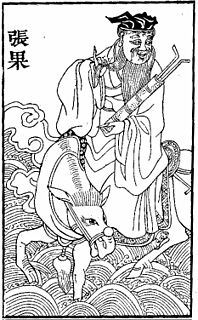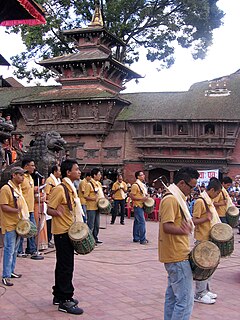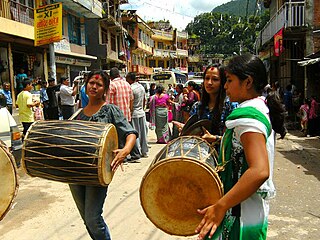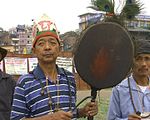Related Research Articles

The drum is a member of the percussion group of musical instruments. In the Hornbostel-Sachs classification system, it is a membranophone. Drums consist of at least one membrane, called a drumhead or drum skin, that is stretched over a shell and struck, either directly with the player's hands, or with a percussion mallet, to produce sound. There is usually a resonance head on the underside of the drum, typically tuned to a slightly lower pitch than the top drumhead. Other techniques have been used to cause drums to make sound, such as the thumb roll. Drums are the world's oldest and most ubiquitous musical instruments, and the basic design has remained virtually unchanged for thousands of years.

A percussion instrument is a musical instrument that is sounded by being struck or scraped by a beater including attached or enclosed beaters or rattles struck, scraped or rubbed by hand or struck against another similar instrument. Excluding zoomusicological instruments and the human voice, the percussion family is believed to include the oldest musical instruments.

Throughout history, various methods of musical instrument classification have been used in organology. The most commonly used system divides instruments into string instruments, woodwind instruments, brass instruments and percussion instruments; however, other schemes have been devised.
A membranophone is any musical instrument which produces sound primarily by way of a vibrating stretched membrane. It is one of the four main divisions of instruments in the original Hornbostel-Sachs scheme of musical instrument classification.

Dhol can refer to any one of a number of similar types of double-headed drum widely used, with regional variations, throughout the Indian subcontinent. Its range of distribution in India, Bangladesh and Pakistan primarily includes northern areas such as the Punjab, Haryana, Delhi, Kashmir, Sindh, Assam Valley, Uttarakhand, West Bengal, Gujarat, Maharashtra, Konkan, Goa, Karnataka, Rajasthan, Bihar, Jharkhand and Uttar Pradesh. The range stretches westward as far as eastern Afghanistan. A related instrument is the dholak or dholki.

The goblet drum is a single head membranophone with a goblet shaped body used mostly in Egypt & Saudi Arabia, also in parts of the Middle East, North Africa, South Asia, and Eastern Europe. The African djembe-wassolou is also a goblet membranophone. This article focuses on the Eastern and North-African goblet drum.

The fish drum is a Chinese percussion instrument. The name actually designates two rather different instruments, a membranophone and an idiophone.

A friction drum is a musical instrument found in various forms in Africa, Asia, Europe and South America. In Europe it emerged in the 16th century and was associated with specific religious and ceremonial occasions.

The janggu or sometimes called seyogo is the most representative drum in traditional Korean music.. It is available in most kinds, and consists of an hourglass-shaped body with two heads made from animal skin. The two heads produce sounds of different pitch and timbre, which when played together are believed to represent the harmony of man and woman. Janggu [장구] is one of instruments of Samulnori [사물놀이]. Samulnori consists of Janggu, Buk [북], Jing [징] and kkwaenggwari [꽹과리]
The pakhavaj is a barrel-shaped, two-headed drum, originating from the Indian subcontinent, a variant and descendant of the older mridang. The kendang of Maritime Southeast Asia is a distant relation of the pakhawaj and other South Asian double-headed drums.

Newa music, also spelled Newar music, is traditional music developed in Nepal by the Newars. The music has its roots in classic Hindu and Buddhist music. It evolved with incorporation of folk music of the Kathmandu valley and its peripheries. Musical instruments mainly consist of percussion and wind instruments.

Dhimay, Dhimaya or Dhime (धिमे) is a drum, and according to the Sachs-Hornbostel classification belongs to the category of double-headed cylindrical membranophone.

The naqqāra, nagara or nagada is a Middle Eastern drum with a rounded back and a hide head, usually played in pairs. It is thus a membranophone of the kettle drum variety.
Khin is a classical membranophone used in Newar music. Khin are played in pair putting on lap by the players facing each other.

A musical instrument is a device created or adapted to make musical sounds. In principle, any object that produces sound can be considered a musical instrument—it is through purpose that the object becomes a musical instrument. The history of musical instruments dates to the beginnings of human culture. Early musical instruments may have been used for ritual, such as a horn to signal success on the hunt, or a drum in a religious ceremony. Cultures eventually developed composition and performance of melodies for entertainment. Musical instruments evolved in step with changing applications and technologies.

Gunlā Bājan is devotional music played by the Newars of Nepal. "Gunla" is the name of the tenth month in the Nepal Sambat calendar, which corresponds to August in the Gregorian calendar and "bajan" means "music" and "music playing group".

There are several overlapping schemes for the classification of percussion instruments.

The conservation and restoration of musical instruments is performed by conservator-restorers who are professionals, properly trained to preserve or protect historical and current musical instruments from past or future damage or deterioration. Because musical instruments can be made entirely of, or simply contain, a wide variety of materials such as plastics, woods, metals, silks, and skin, to name a few, a conservator should be well-trained in how to properly examine the many types of construction materials used in order to provide the highest level or preventive and restorative conservation.
References
This article needs additional citations for verification .(May 2009) (Learn how and when to remove this template message) |
- 1 2 "Membranophones". Jwajalapa!. newatech, inc. 1 May 2008. Archived from the original on 24 February 2012. Retrieved 14 October 2016.

